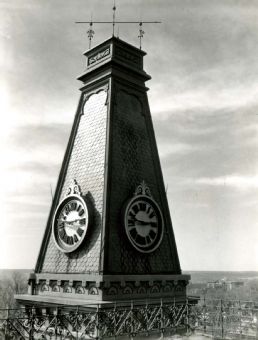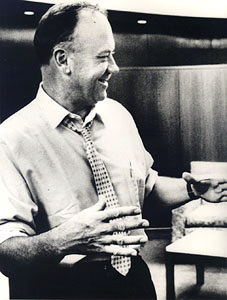"Pivotal Figure in Journalism," Barney Kilgore '29, Subject of New Biography
February 6, 2009
 February 6, 2009, Greencastle, Ind. — The remarkable story of the 1929 DePauw University graduate who was named "Business Journalist of the Century" is told in a new book, Restless Genius: Barney Kilgore, The Wall Street Journal, and the Invention of Modern Journalism. Written by Richard J. Tofel, the text tells "the story of the man who transformed the Wall Street Journal -- and modern media." It includes a chapter entitled "Hoosier Beginnings," which contains much detail of Kilgore's years at DePauw (where he served as editor of the student newspaper, The DePauw), as well as information on the University itself.
February 6, 2009, Greencastle, Ind. — The remarkable story of the 1929 DePauw University graduate who was named "Business Journalist of the Century" is told in a new book, Restless Genius: Barney Kilgore, The Wall Street Journal, and the Invention of Modern Journalism. Written by Richard J. Tofel, the text tells "the story of the man who transformed the Wall Street Journal -- and modern media." It includes a chapter entitled "Hoosier Beginnings," which contains much detail of Kilgore's years at DePauw (where he served as editor of the student newspaper, The DePauw), as well as information on the University itself.
"Barney Kilgore is a legend to those of us who work in journalism," says James B. Stewart, the Pulitzer Prize-winning investigative journalist and author who is a 1973 graduate of DePauw. "Now Richard Tofel brings him to life for a wide audience in this vivid, insightful, compelling biography. With traditional journalism under siege from the Internet, the story of how Kilgore created and implemented new and higher standards of reporting and writing couldn’t be more timely. More than any single person, Kilgore made the Wall Street Journal the pillar of journalism it is today and hopefully will remain for many  generations."
generations."
"The University in which Barney Kilgore enrolled was, by the standards of the Midwest, quite venerable," writes Tofel, noting that even then the school was known for its role in producing fine journalists and is the birthplace of the national journalism fraternity now known as the Society of Professional Journalists.
The chapter on Kilgore's early years tells of how he joined the debate team and took part in theatrical productions before his interest in journalism was sparked during his sophomore year, leading him to work on the newspaper and the yearbook, The Mirage. His reporting for the newspaper took him, by train, to West Point to cover the Army-DePauw game in 1928. Army won the contest, 38-12, and as Tofel notes, "[Notre Dame coach Knute] Rockne's 'win one for the gipper' speech came one week later at Yankee Stadium in New York City" against the same Army team.
As a senior, Kilgore wrote home to his parents, "The DePauw is coming along better than it was going this time last year by quite considerable and it isn't nearly as much work for me as it was last year either. I have put you on the mailing list so you should get every issue of the paper. Please save them for me if you can because I'd like to keep a complete file and have them bound at the end of the year to show relatives and such."
Upon graduation, Kilgore was hired at the Wall Street Journal by its general manager, 1918 DePauw graduate Kenneth C. "Casey" Hogate, for $40 a week. "Kilgore considered his salary, which is nearly $24,000 today, 'generous indeed,'" writes Tofel.
general manager, 1918 DePauw graduate Kenneth C. "Casey" Hogate, for $40 a week. "Kilgore considered his salary, which is nearly $24,000 today, 'generous indeed,'" writes Tofel.
Kilgore rose to become publisher of the paper and was the longtime president of Dow Jones & Company. In a November 2008 Wall Street Journal piece marking the 100th anniversary of Bernard Kilgore's birth, Tofel wrote that Kilgore "was not only the life force behind the growth of the newspaper you are reading but also the inventor of much of what constitutes modern newspaper journalism."
"One of the forgotten titans in American journalism, Barney Kilgore is the subject of a new book by Tofel, a former assistant publisher of the Wall Street Journal and author of Sounding the Trumpet," notes Publishers Weekly. "A Midwesterner from Indiana, Kilgore emerged from smalltown America to rise through the ranks at the Wall Street Journal on the eve of the Great Depression. Through the war years of the 1940s into the Cold War era, he reshaped the publication's news focus, visuals, composition, circulation and advertising. He championed a unique style of journalism as its top executive, with keen instincts, intelligence and a progressive view, transforming the broadsheet into a first-class national business newspaper. Innovative and unyielding, Kilgore had one of his finest moments when he faced down General Motors in a controversial 1954 advertising spat, bolstering the newspaper's reputation. Tofel's excellent work on this pivotal figure in journalism is a significant addition to the seminal books on American media."
Newsweek editor Jon Meacham adds, "Richard J. Tofel has given us an original, fascinating, and vivid account of the life of an original, fascinating, and vivid man -- Barney Kilgore, who, Tofel brilliantly argues, created modern journalism. As the architect of the Wall Street Journal, Kilgore, beginning at an amazingly young age, invented much of what we take for granted in newspapers, magazines, and online today. Too little known, Kilgore is one of those American figures who needed a great writer to bring him out of the mists of history, and Tofel has done it splendidly. Kilgore would be proud."
has given us an original, fascinating, and vivid account of the life of an original, fascinating, and vivid man -- Barney Kilgore, who, Tofel brilliantly argues, created modern journalism. As the architect of the Wall Street Journal, Kilgore, beginning at an amazingly young age, invented much of what we take for granted in newspapers, magazines, and online today. Too little known, Kilgore is one of those American figures who needed a great writer to bring him out of the mists of history, and Tofel has done it splendidly. Kilgore would be proud."
Barney Kilgore was a loyal alumnus of DePauw and served on the University's Board of Trustees.
Learn more about Restless Genuis, and order the book, at Amazon.com.
James B. Stewart and Casey Hogate were also on the "Business Journalist of the Century" list. Learn more in this story.
Back